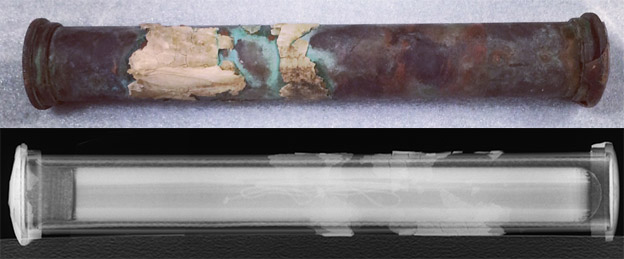Researcher sees through walls of unknown object to solve Hamilton mystery

The capsule, top, was unearthed by construction workers in downtown Hamilton. A researcher at McMaster's Nuclear Reactor used high-tech analysis to see into the object (bottom), and determine its contents.
A McMaster researcher solved a Hamilton mystery – or at least part of one – by confirming that a paper scroll is indeed sealed inside a metal cylinder discovered this summer beneath a monument to the city’s war dead.
Using x-ray fluorescence and neutron radiography at McMaster’s Nuclear Reactor, Brandi Lee MacDonald analyzed the nearly century-old metal cylinder discovered by construction workers under the Gore Park cenotaph.
The technology allowed her to see into the capsule and analyze its construction and contents, which she confirms appears to be a paper scroll wrapped in coarse cloth and tied with a ribbon or string.
When the cylinder was unearthed (by workers reorienting the cenotaph to make way for larger crowds of Remembrance Day observers), Hamilton Public Library archivist Margaret Houghton had said it most likely held a scroll with a list of 1,800 names – Hamiltonians killed during the First World War.
The item is described in a Hamilton Herald article about the dedication of the cenotaph, dated May 23, 1923.
“There’s definitely a rolled-up piece of paper inside, which would indicate that she’s probably correct,” said MacDonald, a research associate in Medical Physics and Applied Radiation Sciences.
The analysis also showed that the capsule’s shaft is made of copper, while the threaded ends are brass. It’s 30 cm long and 5 cm wide.
“The time capsule itself could still very well be air-tight,” said MacDonald.
Conservators are now mulling over what to do with the capsule.
